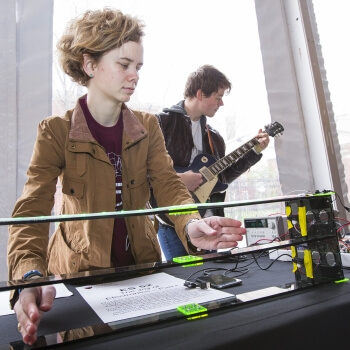News
Earth and planetary sciences concentrator Hannah Byrne, A.B. '18, and computer science concentrator Timothy Tamm, A.B. '18, fill the Science Center Plaza tent with blaring punk rock music using the audio effect block they created for "The Joy of Electronics" (ES 52). Photo by Eliza Grinnell/SEAS Communications.
The fifth annual Design and Project Fair on May 4 was some kind of party, with a robotic wait staff serving the drinks and punk rock music blaring from a customized audio effect block.
Visitors—or partygoers—to this year-end showcase of projects by students at the Harvard John A. Paulson School of Engineering and Applied Sciences walked into the Science Center Plaza tent and entered a world where the possibilities are limited only by what students can imagine.
The projects encapsulated the creativity that is central to engineering and applied science, like the “Anti-Nap Cap,” developed by mechanical engineering concentrators Mike Lessard, S.B. ’17 and Dallas Schray, S.B. ’17. Their Boston Red Sox baseball cap incorporates an accelerometer that measures the tilt angle of the wearer’s head. The device, which the students developed for “The Joy of Electronics” (ES 52), sends a vibration through the cap if that angle drops below a certain threshold, and sounds an alarm if the wearer’s head stays tilted for 20 seconds.
“We never fall asleep in class ourselves, but we have noticed a number of our fellow students sometimes doze off,” Lessard said with a wry smile. “We wanted to develop something that would help them.”
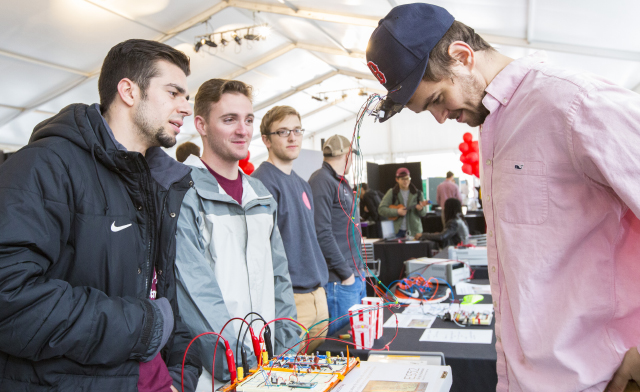
Electrical engineering concentrator Tim McNamara, S.B. '17 (right) tests out the "Anti-Nap Cap" developed by mechanical engineering concentrators Dallas Schray, S.B. ’17 (left) and Mike Lessard, S.B. ’17.
While many students would likely consider preventing classroom naps a worthy cause, a number of projects targeted more dire health and safety concerns, such as fatalities from traffic accidents.
Lauren Leatherby, a master’s student at the Harvard Kennedy School, Risham Dhillon, A.B. ’18, a computer science concentrator, and Jocelyn Fu, A.B. ’17, an applied math concentrator, developed a data visualization tool that explores the causes of fatal highway crashes, and the policy efforts that can help prevent them. For their project in “Visualization” (CS 171), they mined traffic fatality data from across the U.S. to produce a series of interactive maps and charts that clearly show, for example, that states with lower speed limits on rural roads also have fewer fatal traffic accidents.
“We learned about the power of being able to visualize data. When you look at spreadsheets, the data doesn’t always make sense,” said Dhillon. “Telling a story with the data can give people a better sense of how different policies could be implemented to prevent fatal crashes.”
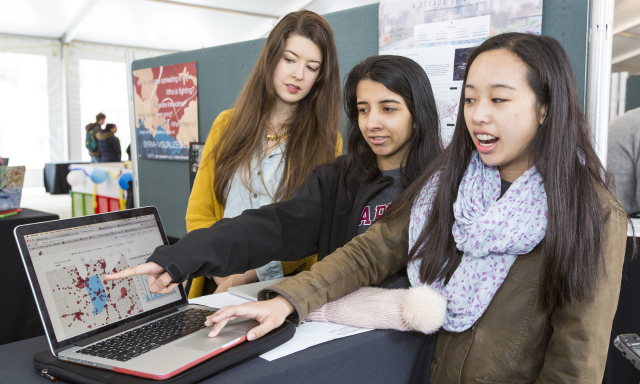
Lauren Leatherby, a master’s student at the Harvard Kennedy School, Risham Dhillon, A.B. ’18, a computer science concentrator, and Jocelyn Fu, A.B. ’17, an applied math concentrator, explain their data visualization project. (Photo by Eliza Grinnell/SEAS Communications.)
Policy is important for improving the safety of our city streets, but how could technology be used to improve safety on an individual level, perhaps for cyclists on dangerous urban roads? Ajay Nathan, A.B. ’18, a computer science concentrator, and Jacques van Rhym, A.B. ’17, an applied math concentrator, have a solution—glasses that can help a cyclist seamlessly navigate from point A to point B, which they developed for “Design Survivor: Experiential Lessons in Designing for Desirability” (ES 22).
LEDs on the sides of the glasses flash to indicate when a cyclist should make a left or right turn, eliminating the need to check a map or directions on a smart phone while pedaling through traffic. They plan to program their prototype using Bluetooth technology so that it can work in conjunction with the Google maps app on a smartphone. A cyclist would simply program his or her route into the phone, and then the glasses would indicate the turns, Nathan explained.
“This project taught me that design is a process that involves both your conception about a product and feedback from others. How you integrate that feedback into your concept is very important,” he said.
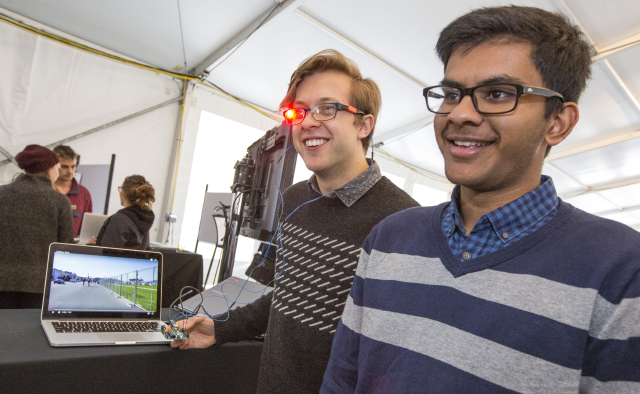
Applied math concentrator Jacques van Rhym, A.B. ’17, (left) and computer science concentrator Ajay Nathan, A.B. ’18, demonstrate the LED glasses they created to help cyclists navigate city streets. (Photo by Eliza Grinnell/SEAS Communications.)
Feedback from users, important during the design phase of an engineering project, was also an essential component of the robot developed by computer science concentrators Fatma Akcay, A.B. ’16 and Emily Wang, A.B. ’18 for the course “Autonomous Robot Systems” (CS 189).
Their robot was programmed to approach an individual and ask if he or she would like to have their photo taken. Depending on the input the individual entered onto the robot’s keypad, the device would take their picture and post it on Twitter (yes, this robot has its own Twitter account). Akcay let out a relieved laugh as she watched her robot operating perfectly, rolling through a “pen” set up in the middle of the tent that also housed the robotic waiters.
“Any developer will tell you the biggest challenge of working with hardware is testing, because a lot of times the hardware fails, and you don’t know if it is your program or the hardware,” she said. “Sometimes it can take hours just to figure out what the problem is.”
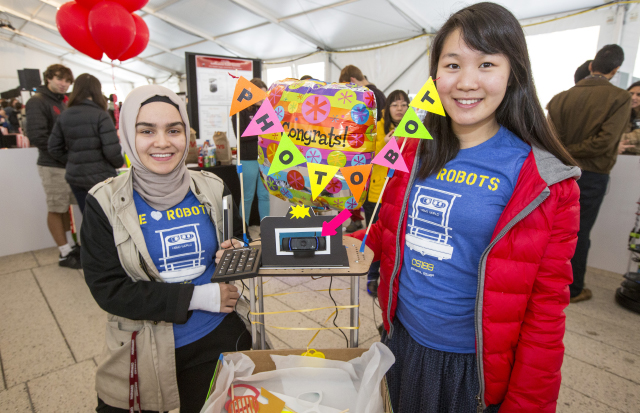
Computer science concentrators Fatma Akcay, A.B. ’16 (left) and Emily Wang, A.B. ’18, pose with their party photo robot. (Photo by Eliza Grinnell/SEAS Communications.)
Those hours of effort, from early morning lectures to midnight scramble sessions in the Active Learning Labs, paid off for the hundreds of students who showed off their handiwork for the entire Harvard community. Demonstrating students’ outstanding projects, and highlighting myriad opportunities for cross-campus collaboration, is what the Design & Project Fair is all about, said Frank Doyle, SEAS Dean and John A. & Elizabeth S. Armstrong Professor of Engineering & Applied Sciences.
“This showcase reveals the brilliant ingenuity of these engineers at Harvard; that they could take the curriculum they learned and integrate that into these design projects is a real testament to their cleverness and the training they’ve been receiving,” he said. “This capstone manifestation of that knowledge is truly impressive.”
Harvard SEAS Design & Project Fair Timelapse 2016
This time-lapse video shows the 2016 Harvard John A. Paulson School of Engineering and Applied Sciences Design and Project Fair. (Video by Eliza Grinnell/SEAS Communications.)
Cutting-edge science delivered direct to your inbox.
Join the Harvard SEAS mailing list.
Press Contact
Adam Zewe | 617-496-5878 | azewe@seas.harvard.edu
